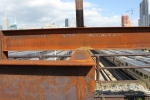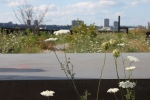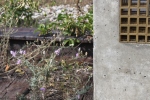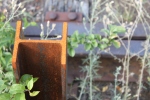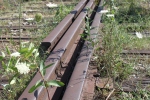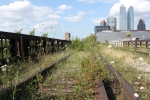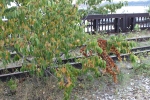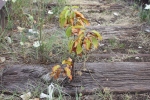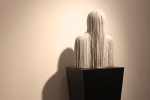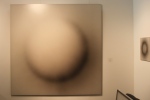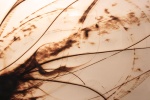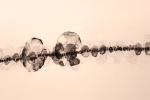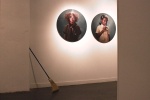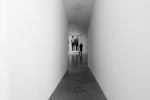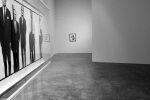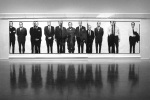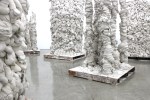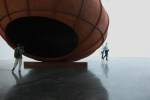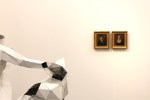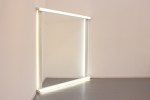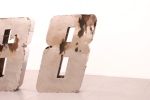Anish Kapoor can not be accused of mediocrity. For decades this Indian born London based artist has occupied his very own place in the contemporary art scene.
Wherever I come across one of his works (Cloud Gate “the bean” in Chicago, Turning The World Upside Down in Jerusalem), I make it a point to observe people looking on. There always seems to be a little or big crowd swarming around his sculptures. Fascination is the least that his work provokes. However deep you are into contemporary art, the sculptures of Kapoor make everyone stand still and watch. First you hold still, than you watch, and then you walk up closer, and closer. And get completely absorbed. In many cases, Kapoor’s work wraps you in, sucks you into a void.
The double exhibition brought by the Gladstone Gallery on two different locations shows different aspects of Kapoor’s art.
In one gallery some 20 sculptures are on view. As simple as they might look, they are not easy to describe. Concrete droppings, drippings, pourings… Some of them definitely look like stalagmites you might encounter in prehistoric caves. They look like formations created by the dripping of water and sedimentation of minerals during millions of years. Their organic forms seem to be the result of a natural phenomenon.
Others take more heaplike shapes, very organic too, like the structures of termites. The concrete is spurted in swirls and curls. Like a huge pile of boa constrictors, squirming and choking eachother. As static as the sculptures may be, they imply movement and formation, a clear action of creation.
Two rooms filled with these sculptures make it feel like walking through a landscape. And although made of hard and inert concrete, the sculptures look organic, soft, and alive.
The second gallery brings a complete different experience. There’s only one work, but it occupies the entire space. Because of its dimensions, it looks as if the gallery has been built around the sculpture.
Entering the gallery, there’s a moment of surprise. The sculpture has an overwhelming presence, because its size, sure. But also because its form. It’s like the sculpture has landed there and has bitten a huge chunk out of the gallery space. It’s balancing precariously on a metal beam.
I feel I have to be very carefull describing this work in words. That is because I am afraid to compare the sculpture to some specific other form that we more easily can recognize. Describing the object itself, and only the object, is like missing out on the essence and the complete experience of the sculpture. And the space! Anish Kapoor not only creates form that stands on its own; it alters and reshapes the space around it.
Inside and outside are two components that mould the space. The outside holds the inside in its grasp. The inside expands in the outside. It’s like breathing in and out.
On entry, this work is a blow in the face. The space is pregnant with the form of the sculpture. This is the outer approach. Walking around it, its true form starts to show itself, and it changes as you change your point of view. From symmetrical it turns to a more organic shape, like a softer mass.
Walking behind it, it completely closes up. Then it opens up like the mouth of a whale. Then you go closer and this amorph creature swallows you up, from your head down to your knees.
And then there is nothing. Then there is darkness. Here is one of the things, or maybe thé thing, Kapoor undoubtedly does best. He lets you see the inside of nothing. Looking into this womb, there is only blackness. Empty space. Void.
There is nothing as confronting as an empty space. Selfconfronting! The outside exists no longer. You don’t see it anymore. You even don’t hear it anymore. Every contact with the outside is cut off. Suddenly you hear yourself. A little cough. A word. An ah. And it speaks back to you.
When I had finished my three tours around this friendly monster, one young man walked up to the gaping mouth and started whistling. The monster whistled back. Some other people walked in, turned around and walked out. They must have missed it. They must have only seen the “nothing”.
Gladstone Gallery, NYC
515 W 24th
530 W 21st
Till June 9
gladstonegallery.com

















